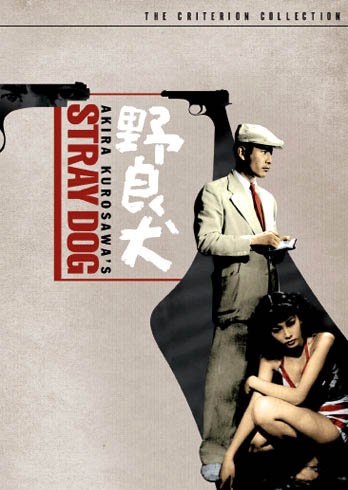|
Reviews of Recent Independent, Foreign, & Documentary Films in Theaters and DVD/Home Video
STRAY DOG (1949)
A rookie homicide detective, Murakami (Toshiro Mifune), searches for his
gun stolen on a packed bus. In the hot, sizzling days of a Japanese
summer, he tracks down, one
by one, those who hold clues to his gun's whereabouts. Evidence points to
it being used in a robbery and a killing. With
persistence and patience, the guilt-ridden greenhorn gradually corners the
culprit by teaming up with a veteran cop (Takashi Shimura) who, unlike
Murakami, sees the world in black and white.
Stray Dog, considered the first police detective film in
Japan, is more than just a mystery. The film's main goal is
to follow the thought process of the detectives.
With depth and realism, Kurosawa makes his characters rich
with personality. The diligent rookie is impulsive and quick to
make assumptions, whereas the senior detective chooses his next step by
careful observation and constructive thinking. Filmed on the streets of
Occupied Japan, including the area of an actual black market, the
documentary-like ambiance brings an understanding of impoverished
post-war Japan - where rice rationing cards were a premium - and to the
charactersí motivations. The gun thief is portrayed not
as strictly as a villain, but as a confused, even betrayed, young veteran of
WWII. (Murakami, likewise, had also served in the war and had come back
penniless). Even a cynical prostitute has an unexpected moment of hope.
The
photography, depicting
the excruciatingly steamy, nauseating season of summer, is art in
itself, capturing a time contrasting to the clean, high-tech Japan of
today. Light is realistically reflected on the glimmering sweat drops on
people's faces, which appear beautifully in black and white. And music is
cleverly used throughout;
the counterpoint music technique is of particular acclaim, as pop music
ironically amplifies the tension as the
hunter confronts the hunted.
DVD Extras: The 32-minute documentary of Kurosawa's making of Stray Dog,
filled with details of what went through his mind when creating the film, is gold to
filmmakers. Beginning with Kurosawa's words, "A good film is fun, nothing complicated -
interesting and easy to understand," it shows step-by-step, with interviews of the crew, the
process of making Stray Dog. Seeing this we find Kurosawa's hidden intentions, trials
and tribulations, techniques, original plans and changes. This content is elaborated by the
commentary by Stephen Prince. Like reading between the lines of a book, Prince
provides analysis and interpretation of each scene, as well as historical background. He also
translates in detail the delicate jokes and phrases of that time.
The essay booklet includes the invaluable synopsis of Stray Dog written by Kurosawa
himself. He explains the events that surrounded the making of the film, such as his rage against
the false accusation from the Society for the Prevention of Cruelty to Animals that he injected a
healthy dog with rabies to get the shot of a fierce-looking, panting dog. With these supplementary
guides and stories behind the scenes, one is undoubtedly able to appreciate the classic much
more. Hazuki Aikawa, journalist, director of the documentary Yancha
|
